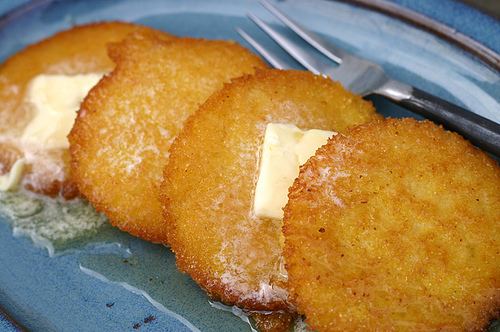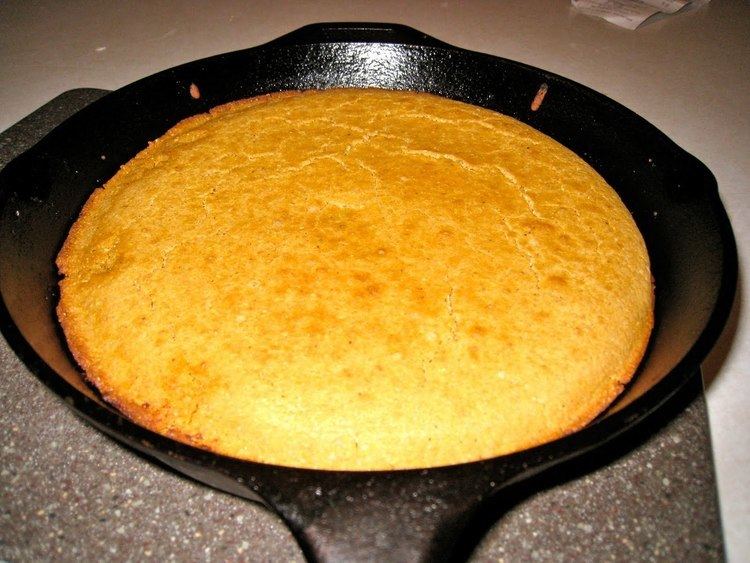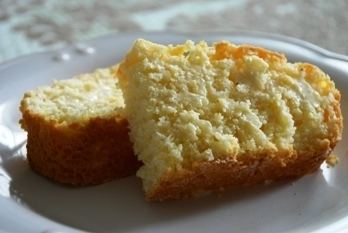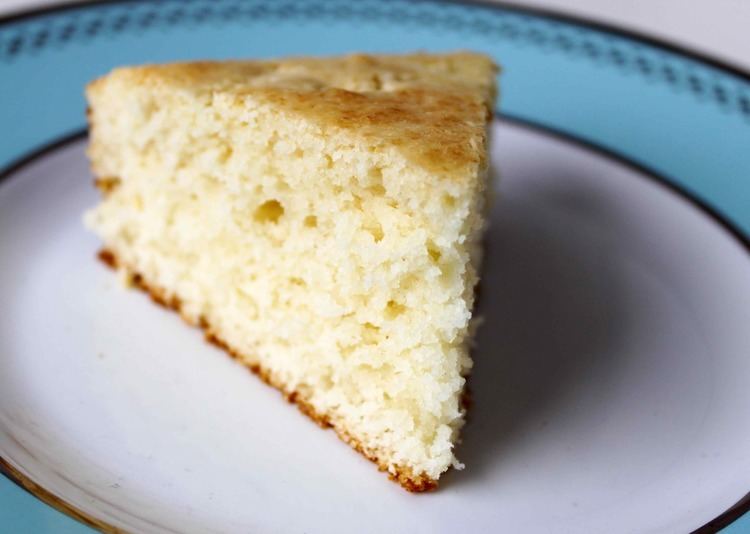Main ingredients Cornmeal Main ingredient Cornmeal | ||
 | ||
Alternative names Jonnycake, shawnee cake, hoecake, johnny cake, journey cake, and johnny bread Similar Bread, Cornmeal, Hushpuppy, Cornbread, Callaloo | ||
How to make hoe cakes or johnnycakes for pioneer recipes
Johnnycake—also called jonnycake, johnny cake, journey cake, shawnee cake, or johnny bread—is a cornmeal flatbread. An early American staple food, it is prepared on the Atlantic coast from Newfoundland to Jamaica. The food originates from the native inhabitants of North America. It is still eaten in the West Indies, Dominican Republic, Saint Croix, Bahamas, Colombia, and Bermuda as well as in the United States.
Contents
- How to make hoe cakes or johnnycakes for pioneer recipes
- Belizean johnnycakes
- Johnnycake
- Hoecake
- Origin
- Preparation
- Australia
- Dominican Republic
- Puerto Rico
- United States
- Jamaica
- References
The modern johnnycake is found in the cuisine of New England, and often claimed as originating in Rhode Island. A modern johnnycake is fried cornmeal gruel, which is made from yellow or white cornmeal mixed with salt and hot water or milk, and sometimes sweetened. In the Southern United States, the word used is hoecake, although this can also refer to cornbread fried in a pan.

Belizean johnnycakes
Johnnycake

The earliest attestation of the term "johnny cake" is from 1739 (in South Carolina); the spelling "journey cake" is only attested from 1775 (on the Gulf coast), but may be the earlier form.

The word is likely based on the word "Jonakin," recorded in New England in 1765, itself derived from the word "jannock," recorded in Northern England in the sixteenth century. According to Edward Ellis Morris, the term was the name given "...by the [American] negroes to a cake made of Indian corn (maize)."
Another suggested derivation is that it comes from Shawnee cake although some writers disagree.
Hoecake
According to the Oxford English Dictionary, the term hoecake first occurs in 1745, and the term is used by American writers such as Joel Barlow and Washington Irving. The origin of the name is the method of preparation: they were cooked on a type of iron pan called a hoe. There is conflicting evidence regarding the common belief that they were cooked on the blades of gardening hoes. A hoecake can be made either out of cornbread batter or leftover biscuit dough. A cornbread hoecake is thicker than a cornbread pancake.
Origin

Native Americans were using ground corn for cooking long before European explorers arrived in the New World. The johnnycake originates with the native inhabitants of Northern America; the Algonquians of the Atlantic seaboard are credited with teaching Europeans how to make the food.
Southern Native American culture (Cherokee, Chickasaw, Choctaw, Creek) is the cornerstone of Southern cuisine. From this culture came one of the main staples of the Southern diet: corn (maize). Corn was used to make all kinds of dishes from the familiar cornbread and grits to liquors such as whiskey and moonshine, which were important trade items. Cornbread was popular during the American Civil War because it was very cheap and could be made in many different sizes and forms. It could be fashioned into high-rising, fluffy loaves or simply fried for a fast meal.
To a far greater degree than anyone realizes, several of the most important food dishes that the Southeastern Indians live on today is the "soul food" eaten by both black and white Southerners. Hominy, for example, is still eaten ... Sofkee live on as grits ... cornbread [is] used by Southern cooks ... Indian fritters ... variously known as "hoe cake", ... or "Johnny cake." ... Indian boiled cornbread is present in Southern cuisine as "corn meal dumplings", ... and as "hush puppies", ... Southerners cook their beans and field peas by boiling them, as did the Indians ... like the Indians they cure their meat and smoke it over hickory coals.
Preparation
Johnnycakes are an unleavened cornbread made of cornmeal (but see the Australian version below), salt, and water. Early cooks set thick corn dough on a wooden board or barrel stave, which they leaned on a piece of wood or a rock in front of an open fire to bake. Hoecake was traditionally cooked on a hoe: "Hoe-Cake: A cake of Indian meal, baked before the fire. In the interior parts of the country, where kitchen utensils do not abound, they are baked on a hoe; hence the name."
In the American south during the 18th century versions were made with rice or hominy flour and perhaps cassava. A 1905 cookbook includes a recipe for "Alabama Johnny Cake" made with rice and 'meal'.
The difference between johnnycake and hoecake originally lay in the method of preparation, though today both are often cooked on a griddle or in a skillet. Some recipes call for baking johnnycakes in an oven, similar to corn pones, which are still baked in the oven as they were traditionally.
Johnnycakes may also be made using leavening, with or without other ingredients more commonly associated with American pancakes, such as eggs or solid fats like butter. Like pancakes, they are often served with maple syrup, honey, or other sweet toppings.
According to the manuscript of America Eats, a WPA guide to American food culture in the beginning decades of the twentieth century, Rhode Island "jonny cakes" were made in the 1930s as follows:
In preparation, [white corn] meal may or may not be scalded with hot water or hot milk in accordance to preference. After mixing meal with water or milk it is dropped on a smoking hot spider [pan] set atop a stove into cakes about 3"x3"x1/2" in size. The secret of cooking jonny cakes is to watch them closely and keep them supplied with enough sausage or bacon fat so they will become crisp, and not burn. Cook slowly for half an hour, turn occasionally, and when done serve with plenty of butter.
Australia
In Australia, the word "Johnnycake" refers to a quick bread made with flour rather than cornmeal; the cakes are baked in the hot ashes of a fire or fried in fat in a skillet.
Dominican Republic
Yaniqueques or yanikeke are a Dominican Republic version of the jonnycake, supposedly brought over in the 19th century by the Cocolos, or English-speaking migrants (possibly of Afro-Caribbean descent). These cakes are made with flour, baking powder, butter and water; however, they are typically deep-fried. They are a popular beach snack, especially in Boca Chica.
Puerto Rico
Both flour and cornmeal johnny cakes are popular beach food in Puerto Rico. They came to Puerto Rico from all over different parts of the Caribbean, notably of Dominican and Jamaican descent. They are deep-fried as most johnny cakes are and stuffed with seafood or as a sweet snack similar to funnel cake sprinkled with sugar and cinnamon. The recipe is similar to that found in other regions; flour or cornmeal with butter and baking soda are standard, but sometimes coconut milk is used instead of water.
United States
The modern jonnycake is a staple in the cuisine of New England and New Englanders claim it originated in Rhode Island. A modern jonnycake is fried gruel made from yellow or white cornmeal that is mixed with salt and hot water or milk, and sometimes sweetened. In the Southern United States, the same food is referred to as hoecake.
Jamaica
Johnnycake is a traditional staple across the island. Some people call these fried dumplings whilst others say fried Johnnycakes. Recipe incorporates flour, sugar, salt, baking powder, margarine or butter and water or milk. Once kneaded, the dough is fried in cooking oil.
